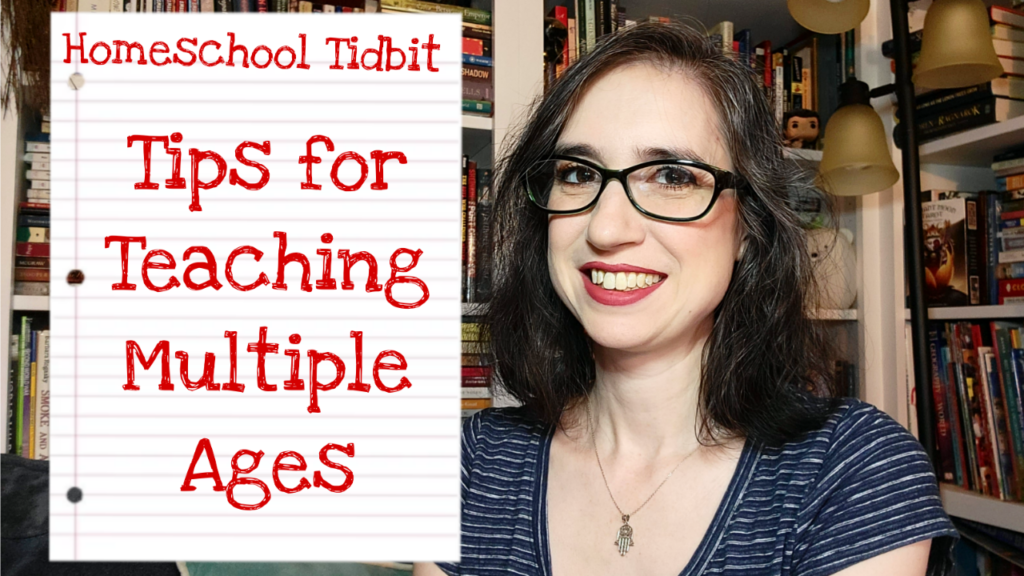Homeschool Tidbits: Tips for Teaching Multiple Ages
September 15, 2023

Welcome to Build Your Library’s Homeschool Tidbits: Episode 58 – Tips for Teaching Multiple Ages. In this weekly video series, I will delve briefly into a topic related to homeschooling. I will share some of my knowledge and expertise as a long-time homeschooling mother of 4 children. Three of whom have graduated high school, and one who is a college graduate!
When I first began homeschooling, I had a 4-year-old and 1-year-old twins. My goals then were to get through the day without losing my mind.
Fast forward a few years, and I had an 8-year-old and 5-year-old twins. That was the year I homeschooled all three for the first time. I made the decision that they would all learn the same content subjects. So, when we started our morning, we all worked together – we listened to our family read aloud, read from our history or science or whatever we were currently learning, and then broke off into individual work.
I am a firm believer in keeping your homeschool simple. And that means streamlining whenever possible. If I had tried to do individual work with each of my children for every subject, my days would have been very long and very stressful. So I streamlined. And I did that until my oldest started high school. By that point, she was primarily independent anyhow. But for the majority of our homeschooling, we were family-schooled.
One of my favorite benefits of this method of homeschooling is the family bond I often talk about. We shared the same read-alouds and studied the same things, so we all worked and learned together. I loved those years. I love how close it brought my children and how many stories, subjects, and projects we can still remember and talk about from those years of family learning.
But how does it work on the daily?
The way I often describe this method to people is to think of being on a bus. We all get on simultaneously, and we do our family subjects first. Maybe that’s a morning basket, read-aloud, history, and science. Then, when it’s time for things like math and language arts, kids get off the bus to do their independent work. Each of them gets one-on-one time with me as needed, but I don’t have to be with everyone at the same time. I’m still driving the bus, but along the way, my kids have gotten off at their stops.
The Importance of Independent Work
That analogy works to a point, but when you are looking at your schedule, I recommend looking for times when you can assign independent work to one child while you are working with another. Your oldest can do their grammar and reading while you work on phonics or math with your younger child.
What if you have more than two kids? It works the same way – have things they can do that don’t require your assistance while you work with the others. Maybe that looks like a coloring page, a video, or a computer game for a younger child while you work with an older child.
This is where fostering independence begins. Even a young child can be given a simple assignment – color a picture, practice handwriting, watch a short educational video – so that you can focus on something else, whether homeschooling or loading the dishwasher.
As your children get older, they can take on more and more independent work. But you can still maintain those family subjects where you all learn something together. This will change as your children get older, but the essence remains.
Learning together as a family is such a gift to all of you. I’ve loved homeschooling my children, and I am so glad we have so many family bonding moments to look back on. I wish the same for you!
Coming up next…
I hope you found this Tidbit helpful! Come back next week for more homeschooling inspiration!
Until then, happy reading!
See Other Related Articles:
- Happy, Hygge Homeschooling?
- “Are worms made out of metal?” And other great rabbit trails.
- Charlotte Mason in the Secular Homeschool
- A Literary Education book
- About Build Your Library
- Homeschool Tidbits: Build Your Library’s Weekly Video Blog Series
.
 Emily Cook is the author and creator of the secular homeschool curriculum Build Your Library, a literature-based K-12 program infused with the teachings of Charlotte Mason. She writes full-year lesson plans as well as shorter topical unit studies. Emily has been homeschooling her four children in Southern NH for 21 years. She is passionate about reading aloud to children of all ages and loves sharing her love of literature. She and her family also make incredibly dorky videos about homeschooling, books, and more on YouTube at ARRRGH! Schooling. You can follow her on Facebook, Twitter, and Pinterest. You can also check out her author page on Amazon.
Emily Cook is the author and creator of the secular homeschool curriculum Build Your Library, a literature-based K-12 program infused with the teachings of Charlotte Mason. She writes full-year lesson plans as well as shorter topical unit studies. Emily has been homeschooling her four children in Southern NH for 21 years. She is passionate about reading aloud to children of all ages and loves sharing her love of literature. She and her family also make incredibly dorky videos about homeschooling, books, and more on YouTube at ARRRGH! Schooling. You can follow her on Facebook, Twitter, and Pinterest. You can also check out her author page on Amazon.
